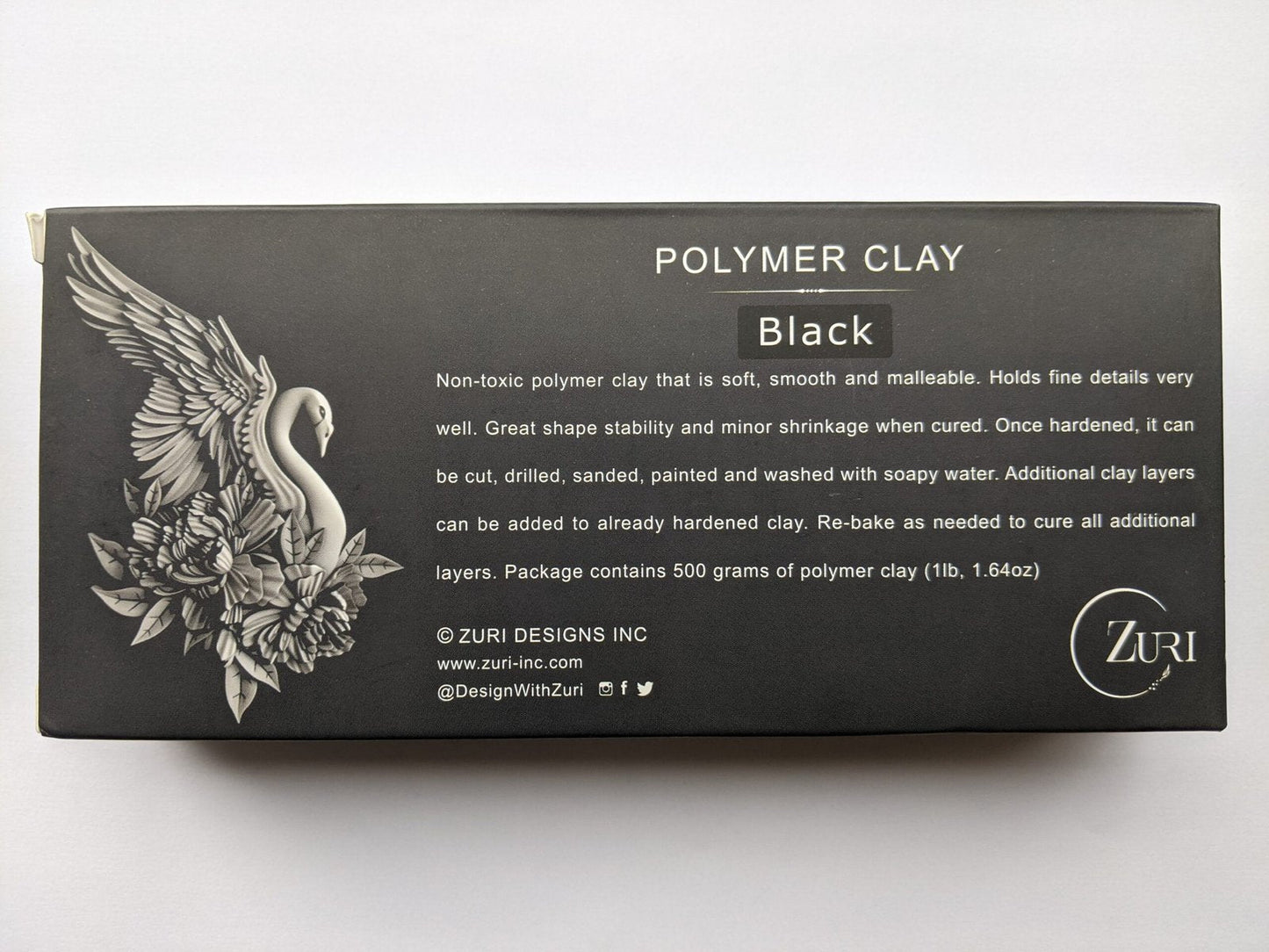Zuri Designs
Black Polymer Clay by Zuri Designs
Black Polymer Clay by Zuri Designs
Couldn't load pickup availability
Zuri Designs Black Polymer Clay that is non-toxic, soft, smooth, and malleable. Holds fine details very well. Great shape stability and minor shrinkage when cured. Once hardened, it can be cut, drilled, sanded, and painted and washed with soapy water. Additional clay layers can be added to already hardened clay. Re-bake as needed to cure all additional layers. Package contains 500 grams of polymer clay (1lb 1.64ounces).
Also available in white.
How to Use This Polymer Clay:
Remove the desired amount of clay from the package and seal the package thoroughly, to make sure that the leftover clay has minimal contact with air. Condition the clay, then pack the mold with it, leveling at the top. You can dust the mold with a fine layer of corn starch to prevent the clay from sticking to the mold. Pre-heat your oven. Our polymer clay has been designed to tolerate oven temperature ranges from 248-266 Fahrenheit (120-130 Celsius). You can remove the clay form the mold before baking, or if you are using a Zuri Designs mold, you can bake the clay in the mold. Place the uncured clay or packed mold on an aluminum foil piece or baking tray in the oven and bake for 30 minutes per 1/4 inch (6.5mm) clay thickness. For molds with thinner details, tent with aluminum foil to prevent burning. Remove from oven and allow to completely cool down before manipulating.
Not conditioning your clay. One of the most common mistakes when using polymer clay is not conditioning the clay well enough. Do not assume that because the clay is soft it doesn’t need conditioning. It does.
Air bubbles. Avoid trapping air in your clay, particularly when you use a pasta machine for conditioning and sheeting. Air trapping often happens when you fold a sheet of clay in half and run it through the pasta machine starting at the edge of the sheet. Instead, feed the folded clay sheet into the pasta machine starting at the fold. That way, air is being pushed out from between the two halves of the clay sheet. Failure to do so will most likely result in bubbling and cracks in your finished product.
Expired product. Yes, polymer clay does expire. If unused for long periods of time, even if well packed, it will still harden beyond usable form. At times, you may be able to soften it by adding a few drops of baby oil, but more often than not it becomes hard and brittle, no matter how much you condition it. Therefore, never hoard clay blocks. Buying them on an ‘as needed’ basis will have you a lot of money.
Failure to clean work surfaces. Clay is a sticky product, so things will have no trouble adhering to it. Things like lint, dust, dirt of any kind, pet hair and so on. It is worth taking the extra minute to wipe your work surfaces clean with a wet wipe before working with clay.
Failure to preheat the oven. Many clay crafters do not preheat their ovens when baking their polymer clay pieces. Preheating your oven will help to curtail oven spikes and risk the burning of your pieces. Placing your pieces in an already HOT oven will ensure that they cure at the correct temperature over the correct length of time. So many mistakes as burning, cracking, and scorching can be completely avoided simply by preheating your oven
Under-baking polymer clay. If you are a clay crafter, you are certainly familiar with the hideous cracks that sometimes appear on the beautiful surface of your finished polymer clay product. In some instances, the clay quality is the culprit, but in most cases, cracks are caused by under-baking. Under-baking can often occur when you do not pre-heat the oven, or miscalculate the time needed to bake your piece. To avoid these issues, always pre-heat the oven and make sure you follow the clay manufacturer’s instructions about how long to bake the clay based on the thickness of the piece. If your project has multiple thicknesses, make sure you select the baking time based on its thickest part. Some crafters are reluctant to sufficiently bake their creations, as they believe that they may burn. This, however, will not happen if you follow instructions properly, and if you pay attention to avoid all the mistakes listed herein. Polymer clay does not burn unless it reaches temperatures near 350°F (176°C). If you have burned polymer clay, you need to address your oven, not your baking times.
Using Nail Polish as a Polymer Clay Glaze. Nail polish on polymer clay will very often turn sticky and goopy over time. While some brands of nail polish may not affect your clay, it is better not to risk it.
Using a Spray Varnish on Polymer Clay. With very few exceptions, most brands of spray varnish remain sticky when applied on polymer clay. If you didn’t know that and the damage is already done, use a wipe doused with 91% isopropyl alcohol, as it will remove the spray varnish in most cases.
Embedding Eyepins Without a Kink. If you make a piece of jewelry, always remember to make a kink in the eyepin before embedding it in the clay.
Share

